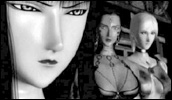Malice@Doll
- Year
- 2001
- Original title
- Malice@Doll
- Director
- Cast
- Running time
- 74 minutes
- Published
- 12 May 2003



by Jasper Sharp
Things have certainly moved a long way since 1995, when Disney-Pixar's Toy Story (directed by John Lasseter), the first feature film to be fully animated by computer, was released into theatres worldwide. There was a brief delay before Disney's main rival in the field, DreamWorks SKG, got in on the act with Antz (1998), its release coming almost hand in hand with the first company's A Bug's Life the same year, but arguably the DreamWorks film suffered for the very reason Disney's one worked. With notably more detail to the images, it was too busy trying to showcase the technical advances its makers had made in the medium to tell a good and simple story, which was one of Toy Story's greatest assets.
Since then, CGI technology has come on in leaps and bounds, with every year producing at least a couple of new marker points for this exciting new animation format. But laying the annual releases of the two main companies pioneering the field side by side - for example Shrek (2001) and Monsters Inc. (2002) - it's clear that Disney's approach of simplification and anthropomorphism works in its favour. If any further proof was needed, it would have had to have come from neither Disney or DreamWorks, but with the mammoth-budgeted US-Japan co-production Final Fantasy: The Spirits Within (Hironobu Sakaguchi, 2001), which still represents the technical apogee as far as CGI is concerned. With every skin blemish and strand of hair modelled to perfection, Final Fantasy's characters were more human than human. Or so they said. One thing that the film did highlight was that it takes more than something to look and act human for it to seem human. And besides, with all the thousands of people listed in the end credits, somewhere along the line they forgot to hire someone to write a decent script. Final Fantasy was a groundbreaking technical exercise, but not a very good film. By the time the critics had had their say, few were even curious enough to take a look at what then represented, and still does, the state of the art of computer animation.
But for all that, Final Fantasy still remains a fascinating case study, in that it clearly represents an evolutionary dead end. After all, CGI technology is endless in its possibilities, so perhaps this almost anal obsession with modelling every drop of water or snowflake to the utmost degree of lucidity is missing the point. If the truth be known, after years of gushing and wowing at these plastic-looking attempts at reconstructing reality, Pete Lord and Nick Park's plasticine poultry in Chicken Run (2000) were the last animated heroes to invoke genuine feelings of empathy or amusement in me, and watching Koji Yamamura's entirely hand-rendered shorts recently, it became all the more clear that, whatever medium the animator decides to work in, filmic realism is just one of many paths for the animator to follow, and not quite the end in itself that some seem to envisage. Animation should be about creating new worlds, not emulating the real life one.
In this respect, perhaps Malice@Doll represents a more auspicious direction for the medium. After Final Fantasy, it is the second piece of CG animation with Japanese input to be showcased in the West, though both its origins and aspirations are somewhat more humble. Rather than a $140 million epic, the Artsmagic release of Malice@Doll is a compendium of three edited-together episodes originally released straight to video in Japan - rendering for video requires a lot less time and expense than the higher-resolution demands of the big screen. Coming from a background in conventional animation too, as opposed to computer games, director Motonaga's approach is rather different from Sakaguchi's. The visuals are a lot simpler, it's true, yet with the approach taken here, just as striking.
Malice@Doll is situated in a rundown future society solely populated by service droids and mechanised prostitutes, where the humans who built them to attend to their carnal needs no longer exist, and the robots follow through their daily programs with no reason or purpose. Malice is one of these pre-programmed prostitutes, first seen exchanging pleasantries with a spider-legged cleaning droid before taking to the streets on her daily patrol repeating her hollow hard-wired mantra, "I will give you a kiss - it's the only thing I can do". When she starts weeping coolant liquid, she goes in search of a repairer droid, but after being diverted from her path by the mysterious ghostly apparition of a young girl, finds herself attacked by a giant tentacled creature. After she recovers from the assault, she discovers she is not quite the doll she used to be, her hard body now turned to flesh after mysteriously being transformed to human form. With much poking and probing, Joe Admin, the large automated being who oversees the movements of the mechanised servants inhabiting this world, establishes that Malice is no longer a robot, and immediately calls upon the other cybernetic streetwalkers to turn against her. Yet Malice fights back, in the only way she knows how, by awakening her fellow servile androids to the pleasures of carnality.
Artsmagic's DVD release of Malice@Doll is an impressive package, sporting not only filmographies of all involved, CGI trailers, and character models, but also a video interview with director Motonaga and scriptwriter Chiaki Konaka. Here the two sketch out their inspiration for the project, which visually, rather than previous CGI releases from around the world, is more informed by the work of the Czech stop-motion doll animators, Jan Svankmajer and Jiri Trnka. Konaka is a prolific and well established screenwriter with work ranging from TV productions such as Ultraman: Toward the Future (1989) and Wizard of Darkness (Eko Eko Azaraku), to the Haunted School series of the late 1990s (Gakko no Kaidan, directed by notable horror practitioners such as Hideo Nakata and Kiyoshi Kurosawa), to the screenplay for Evil Dead Trap 2 (directed by Izo Hashimoto, 1991), and the animated TV series of Serial Experiments: Lain (1998), Digimon (1998), and Hellsing (2001). He also has a rather strange sideline in doll-making, more in the vein of the wide-eyed, idealised femininity so deeply engrained in the Japanese male psyche through decades of anime and manga images, than in the more traditional style adhered to by Japanese stop-motion animator Kihachiro Kawamoto. Western faces, pink bobbed hairstyles, and the finely sculpted curves of their torsos, crafted with a fetishistic attention to detail - Konaka's dolls are the very staple of the otaku fantasy world, the sort of thing that can be found stacked high on the shelves of the Mandarake chain of fanboy shops in Tokyo.
If the realistic movements and facial expressions of the characters of Final Fantasy drew attention, as some have suggested, to the artificiality of these synthespians, then the blank doll-like visages and stiff-limbed gesticulation of Malice@Doll's pixellated heroines make a virtue out of this CGI format, contributing to the surreal, otherworldly atmosphere and the general aura of the hollow superficiality that the future world has the potential to offer us. Motonaga melds these modelled characters seamlessly with a mixture of traditional 2D cell animation and matted, HR Giger-esque backdrops to create a dark, brooding environment, as well as adopting an interesting approach to framing the scenes, going against the grain of the artificial "moving camera" approach utilised by most CGI films in their attempt to increase the illusion of reality.
Arguably the weakest link in the project lies within Konaka's script. Explicitly invoking Lewis Carroll's Alice in Wonderland and the works of Philip K. Dick, its blend of second hand sci-fi tropes seems all too familiar from the world of futuristic anime. It looks great, but does it all really mean anything? Nevertheless, Motonaga's abstracted visuals and the sheer eccentricity of his highly-stylised and solipsistic world are enough to ensure that, even in a few years time after the technology used in Malice@Doll has been left far behind, this particular vision of the future will probably have dated better than many of its bigger budget rivals.